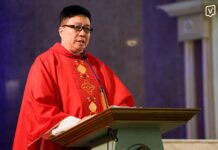AFTER TWO years of the Covid-19 lockdowns forcing Holy Week activities to be observed unconventionally, devotees are excited to celebrate traditionally this year.
Corazon Bayaton, a devout Catholic from UST Senior High School faculty, said she and her family were looking forward to celebrating this year’s Holy Week as they always had before Covid-19.
“I feel happy and excited that this year, we will be able to commemorate the Holy Week because some restrictions were lifted and that we can again observe the Holy Week traditions,” Bayaton told the Varsitarian.
Restrictions on Holy Week observance the past two years included a prohibition on religious activities in some community quarantine classifications, which forced changes on how traditions were observed.
During the early days of the pandemic in 2020, the Vatican decreed that Easter could not be canceled or postponed because it was “the heart of the entire liturgical year and not simply one feast among others.”
Adhering to the Vatican’s directive, the Catholic Bishops’ Conference of the Philippines (CBCP) instructed dioceses to livestream Holy Week rites, emphasizing Domus Ecclesiae or the “Church of the family.”
Priests went around the streets of their parishes on Palm Sunday to bless palm fronds of the faithful in front of their homes. No Holy Water was used during the blessing, as a precaution.
Chrism Mass was held on Maundy Thursday but only the clergy were allowed inside cathedral churches, observing physical distance, hygiene, and sanitation.
For the rite of the “Washing of the Feet,” the CBCP had suggested that it be omitted, or the number of people whose feet would be washed be reduced.
The Visita Iglesia was replaced by the procession of the Blessed Sacrament while the faithful waited at their houses with lighted candles.
Catholics were instructed to follow reflections on the Passion of the Lord on television or the internet before the Veneration of the Cross on Good Friday.
Easter Vigil had a reduced number of readings as allowed by the Roman Missal. The Blessed Sacrament was carried by the presider around the parish, instead of the traditional long procession of the Santo Entierro or the image of the interred Christ.
The faithful were urged to bring a statue of the Blessed Mother at their doors or windows during the Salubong rites at dawn on Easter Sunday.
Bayaton said she and her family would prepare spiritually to have a better Holy Week experience this year.
“Aside from these traditions, what is important is that we also prepare ourselves intrinsically for these Holy Week activities to be more meaningful,” she said.
Fr. Joseph Franz Dizon, parochial vicar of Our Lady of the Holy Rosary Parish in the Diocese of Malolos, said the resilience and faith of Filipino Catholics had been evident amid the Covid-19 pandemic.
“Faith and resiliency always go together,” Dizon said. “Filipinos do not give up on their faith because of their resiliency. Filipinos do not give up on their faith because of their resiliency. They hold on to their faith in times of crisis and calamities lalo na itong Covid-19 pandemic.”
The priest also reminded Catholics to observe health protocols such as wearing facemasks and maintaining social distancing when attending the activities.
On Feb. 22, the Catholic Bishops’ Conference of the Philippines released guidelines for Lent and Holy Week 2022.
In the guidelines, Baguio Bishop Victor Benedico, CBCP Chairman of Episcopal Commission on Liturgy, said Church leaders should coordinate with local officials on religious processions and ensure that social distancing would be observed.
Virtual broadcasts of activities are also encouraged for Catholics who could not attend physically.
Popular devotions like the “Pabasa” may be organized considering compliance with health protocols.
Holy Week will be commemorated from April 10 to April 16. Allyssa Mae C. Cruz
with reports from Ma. Alena O. Castillo














